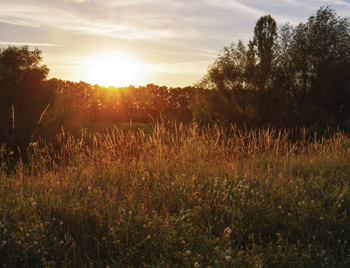
Having begun last month’s article with musings on how important the weather is, to what’s going on in the garden, I am currently even more obsessed than usual due to the ‘Met Office’ warning, for dangerously high temperatures, that is in effect as I write. I’m hoping that, by the time you are reading this, there has been a period of summer rain and a return to more seasonably average temperatures. Although the best way to reduce the need for any artificial irrigation is to plant according to the ‘right plant, right place’ principle, in times of extreme heat and drought watering to keep plants alive is unavoidable.
Watering overnight is best simply because less water is lost by evaporation and more of the precious water gets a chance to penetrate the soil. Also, there is a danger that if you water plants in hot, sunny, weather then the foliage can be damaged by the action of the sun on the wet leaves. Remember that a good, long, soak is far better than just a quick sprinkling with the hose because the latter promotes surface rooting and this will make plants more prone to succumbing to drought in the future.
Damage due to lack of water may not show up immediately, especially in more woody plants, but the stress of being droughted can make plants more susceptible to succumbing to pests and diseases even once ‘normal’ weather conditions have returned. The main consequence of being stressed by lack of water is to speed up the process by which flowering plants finish flowering and set seed. They have evolved in this way as an attempt to ensure that if the drought is severe enough to kill the parent plant then, at least, if it’s completed flowering and managed to produce viable seed then there will be a new generation to take over once more favourable conditions have returned. Seed is designed to remain dormant, but alive, over a long period of time, centuries in the case of some plants which have germinated having been discovered by archaeologists, which is the ultimate insurance policy to guarantee the survival of plant species.
This brings me back, nicely, to the wildflower meadow area, an ‘inoculation patch’ within a larger field, that I sowed in the spring. I did, as ever, leave it a little late to get started with this new area of meadow but the inoculation patch was initially mown off, ‘cleaned up’ with an application of non-persistent herbicide (glyphosate) and the resulting bare circle scarified to open up the soil surface. Although, prior to being killed off with the herbicide, the original vegetation was predominantly italian rye grass (a non-native, ‘alien’, agricultural grass cultivar) with associated agricultural weeds, largely docks, it is interesting to see what has happened to it now.
The ability of seeds to remain dormant, but viable, until conditions are ideal for germination creates what is known as a ‘seed bank’ in any soil where plants have ever grown. One factor that may break the dormancy of seed in the soil is the removal of any vegetation that has, up until the point of removal, shaded the soil and prevented dormant seeds from being exposed to light. Breaking up and turning over the soil will also bring dormant seed to the surface where the exposure to light and air may be the factors that break its dormancy. The addition of moisture, plus spring or summer temperatures, may be the final part of the jigsaw which unlocks the germination process of seeds which have been dormant in the soil for decades.
The relevance of this, to my newly sown wildflower meadow, is that at this point, about three months after sowing, some of the wildflowers are in flower (poppies, cornflowers, ox-eye daisies etc.) but the predominant species, which outnumbers all the newly introduced wildflowers, are annual thistles—‘Sow Thistles’ to be exact. The interesting thing about this is that, in the whole of the rest of the field, there are no sow thistles to be seen. They cannot compete with established plants but, in my inoculation patch, as soon as the competition is removed and the soil surface broken up, then the thousands of thistle seeds, which had been dormant for years, break their dormancy, germinate, grow and, in a matter of weeks, mature to flowering size. Soon they will set seed themselves to add another generation of thistles to the seed bank where they will wait for another time, maybe many years in the future, when they have the perfect conditions to germinate.
The other weed species which is worryingly abundant, having germinated from the seed bank, is the common dock. Docks are present in the existing field mix, they are very difficult to eradicate, so to have large amounts of their seed in the exposed soil of my inoculation patch is not unexpected. What is concerning is that, unlike the annual thistle species, docks are perennial and once established they are very difficult to get rid of and could potentially ruin my planned wildflower meadow due to their ability to out compete everything that I’ve introduced.
If I use a selective herbicide, one that kills broadleaved weeds in established grassland, this will also destroy all the wildflower species which are even more susceptible to weed killers than the much more resilient docks. They are far too numerous for removal by hand, which is pretty difficult anyway due to their tenacious tap roots, so the only option for cultural control is very carefully timed mowing. If they can be mown off before flowering, but after my more precious wildflowers and meadow grasses have managed to set seed, then there is a chance that the dock population will be reduced over time. Mowing the sward short, and often, outside of the growing and flowering season should help to exhaust the established docks, and other rank weeds, while encouraging the finer meadow grasses and wildflower species to compete against them.
In addition, I have been harvesting the seed from ‘Yellow Rattle’, which grows in my more established meadow area, and broadcasting it over the area where I want to establish a new species rich meadow. When I cut my already established meadow, rich with scores of native grasses and wildflower plants, I will spread the mowings over the area surrounding my inoculation patch in once that area has been cut as short as possible. I may attempt a little scarifying of the field surface, wherever I’ve broadcast the rattle and strewn the mowings, to allow the newly introduced meadow plant seeds to gain a foothold—the risk being that I also encourage yet more docks and thistles to emerge from the ancient seed bank alongside them!
Of course, the best thing about covering your allotted patch with a native wildflower meadow is that it should never need to be irrigated and the best thing about grassland, including your domestic lawn, is that no matter how brown and droughted it may get it will always bounce back once the inevitable rains return : watering the lawn, no matter how dry it gets, is simply a profligate waste of this most precious resource.



